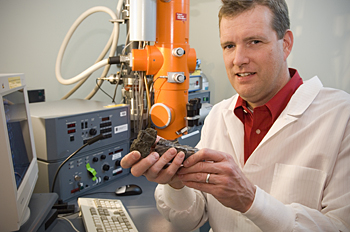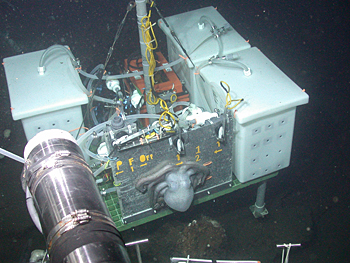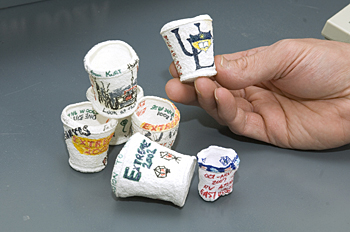
Viruses generally get bad press for living off and infecting other creatures, not to mention their insidious role in human illness. Yet viruses are exceptionally important to life on this planet and there is growing interest in them among members of the scientific community, according to K. Eric Wommack, UD associate professor of plant and soil sciences at the Delaware Biotechnology Institute.
Wommack leads a team that is studying viruses that live at deep-sea hydrothermal vents found thousands of meters beneath the ocean's surface. Co-investigators on the project are Craig Cary, UD professor of marine and earth studies, and Shannon Williamson of the J. Craig Venter Institute. The team also includes UD postdoctoral researcher Rebekah Helton and doctoral student Danielle Winget.
Wommack said that hydrothermal vents, which are characterized by caustic chemistry, hot temperatures and high pressure, are oases of life in the deep sea. The vents provide an ecosystem for ancient and unusual microbes that are capable of extracting energy from volcanic rather than solar energy.
Two decades ago, direct examination of water samples revealed that viruses were extraordinarily abundant within the global ocean, Wommack said, and subsequent research now indicates that viruses are the most abundant life form on Earth.
Within the past year, he added, it has been discovered that DNA viruses comprise the largest pool of uncharacterized genetic diversity in the biosphere.
The central objective of Wommack's research is to explore the abundant, but largely unknown, assemblages of viruses within the hostile environments of the hydrothermal vents. Because viruses can significantly alter the biological characteristics of their microbial hosts, in some cases changing benign bacteria into pathogens, it is possible that viruses at the vents are intimately involved in assisting microbial life cope with the challenging conditions of the deep-sea ecosystem.
The team will collect samples of bacteria and viruses from vents at a dive site near Guaymas, Mexico, and another known as Nine North in the Pacific Ocean that is a two-day ship voyage from Manzanillo, Mexico. After gathering samples, they will then use high-throughput DNA sequencing technology and high-powered computing to analyze DNA sequences.

Wommack said he has a long interest in viruses and has been studying those that are found at deep-sea hydrothermal vents since 2001, when his project co-investigator, Cary, offered him time aboard a research vessel. Cary also has an interest in life at the extremes, and has been active in research at deep-sea hydrothermal vents as well as in the Antarctic.
Wommack said the research is adventurous and that simply collecting samples in the deep-sea environment is difficult work. “Working in the deep sea is extremely challenging. Several thousand meters down, it is cold, it is dark and the pressures are very high. That is something we have to take into account when designing devices to bring samples back,” he said.
In addition to the problems associated with working at extreme depths, Wommack is sampling in parts of the ocean where there is geothermal and volcanic activity. In fact, it is such activity that provides an environment in which viruses can thrive.
Wommack explained the workings of deep-sea vent ecosystems, noting that cold seawater seeps down through the ocean floor where it interacts with volcanic activity, is heated to very high temperatures and is sent back out of the earth, much like the geysers and boiling springs at Yellowstone National Park except deep under water.
While in the earth, he said the water picks up dissolved minerals, primarily sulphur and iron. The water is superheated, to several hundred degrees Celsius above boiling, and when it hits the cold seawater, the minerals fall out, forming chimneys of deposits. The impressive formations can reach tens of meters tall, and through them streams of black water pour out.
The chimneys are a porous type of rock that are hollow in the middle with thick rims in which microorganisms can grow.
Winget, who recently returned from the Pacific, said the environment is a geothermal system that is “not carbon energy-rich but is electron energy-rich.” There is no photosynthesis in this portion of the world that is so far removed from light, and it is volcanic activity that imparts energy to the system.

Wommack said the microorganisms found at the hydrothermal vents are very different from what can be found in more accessible environments. “We are using genetic tools to ask how different are these viruses,” he said, adding, “The overwhelming answer from studies of viruses in other marine environments is that they are very different, because we have never seen anything like them.”
Winget said the team also is studying how microorganisms propagate into new areas. They are interested in determining if viruses are unique to each vent site or part of a generalized system found throughout the ocean.
Researchers are just beginning to understand the enormity of the emerging field. “Microorganisms provide extremely important ecosystem services to the planet,” Wommack said, “and we have no idea what a lot of them are.”
Wommack received his doctorate in marine estuarine environmental sciences from the University of Maryland in 1998, and joined the UD faculty in January, 2001. He received a master's degree in physiology from the University of St. Andrews in Scotland, and a bachelor's degree in biology and economics from Emory University. He holds a joint appointment in the College of Agriculture and Natural Resources and the College of Marine and Earth Studies, and is a member of the Delaware Biotechnology Institute faculty.
Article by Neil Thomas

